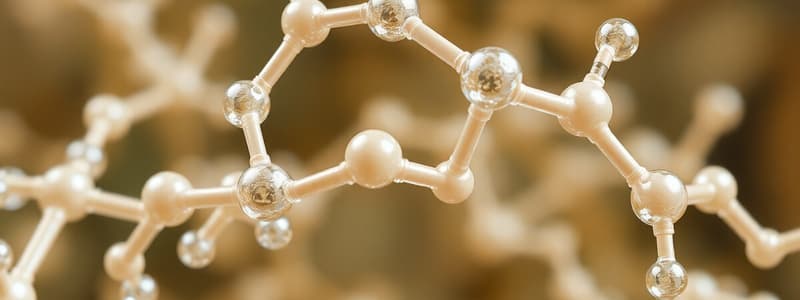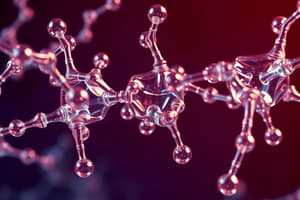Podcast
Questions and Answers
What process do cells use to link monomers together to form polymers?
What process do cells use to link monomers together to form polymers?
- Osmosis
- Hydrolysis
- Hydration
- Condensation (correct)
Which of the following is NOT classified as a macromolecule?
Which of the following is NOT classified as a macromolecule?
- Carbohydrates
- Vitamins (correct)
- Proteins
- Nucleic Acids
What type of bond is formed when two monosaccharides are linked together?
What type of bond is formed when two monosaccharides are linked together?
- Glycosidic bond (correct)
- Ionic bond
- Hydrogen bond
- Peptide bond
Which polysaccharide serves as energy storage in animals?
Which polysaccharide serves as energy storage in animals?
What are the components of a triglyceride?
What are the components of a triglyceride?
What structural feature distinguishes saturated fatty acids from unsaturated fatty acids?
What structural feature distinguishes saturated fatty acids from unsaturated fatty acids?
Which type of carbohydrate is composed of many sugar monomers linked together?
Which type of carbohydrate is composed of many sugar monomers linked together?
Which functional group is commonly found in sugars and contributes to their solubility in water?
Which functional group is commonly found in sugars and contributes to their solubility in water?
What defines an isomer?
What defines an isomer?
In what form do plants primarily store carbohydrates?
In what form do plants primarily store carbohydrates?
What role do enzymes play in biological processes?
What role do enzymes play in biological processes?
Which lipid is known for being an essential component of cell membranes?
Which lipid is known for being an essential component of cell membranes?
Which of the following best describes the structure of amino acids?
Which of the following best describes the structure of amino acids?
What feature of an enzyme's active site makes it specific to one type of substrate?
What feature of an enzyme's active site makes it specific to one type of substrate?
What is the primary structure of a protein?
What is the primary structure of a protein?
What occurs when proteins are denatured?
What occurs when proteins are denatured?
How does the substitution of one amino acid affect hemoglobin?
How does the substitution of one amino acid affect hemoglobin?
What is the main role of insulin in relation to blood sugar levels?
What is the main role of insulin in relation to blood sugar levels?
Which component is NOT part of a nucleotide?
Which component is NOT part of a nucleotide?
What base replaces thymine in RNA?
What base replaces thymine in RNA?
How is energy stored in ATP?
How is energy stored in ATP?
What happens to ATP when it releases energy for cellular work?
What happens to ATP when it releases energy for cellular work?
What is the structure of DNA characterized by?
What is the structure of DNA characterized by?
Which of the following is a property of enzymes?
Which of the following is a property of enzymes?
What role do nitrogenous bases play in nucleic acids?
What role do nitrogenous bases play in nucleic acids?
What type of sugar is found in RNA?
What type of sugar is found in RNA?
How does temperature affect proteins?
How does temperature affect proteins?
Flashcards are hidden until you start studying
Study Notes
Functional Groups
- Groups of atoms that impart specific properties to compounds.
Polymers and Macromolecules
- Large molecules, known as polymers, are constructed from smaller units called monomers.
- Macromolecules in biology encompass polysaccharides, proteins, lipids, and nucleic acids.
Monomers and Linkage
- Monomers are connected through condensation (dehydration synthesis), which removes water to form bonds.
Hydrolysis
- Hydrolysis is the process of breaking down polymers by adding water, thus splitting them into monomers.
Major Macromolecule Categories
- Four primary macromolecule types in cells: carbohydrates, lipids, proteins, and nucleic acids.
Carbohydrates
- Composed of small sugar molecules or long starch molecules.
- Monosaccharides (simple sugars) include glucose, fructose, and galactose, all sharing the same chemical formula (C6H12O6).
- Isomers, like glucose and fructose, have identical formulas but different structures.
- Monosaccharides form ring structures in solution and serve as cellular fuel, primarily in ATP form.
Disaccharides
- Formed by combining two monosaccharides via glycosidic bonds through condensation.
- Common disaccharides include sucrose (glucose + fructose) and lactose (galactose + glucose).
Polysaccharides
- Composed of numerous monosaccharide units linked together, forming complex carbohydrates.
- Examples: Starch (energy storage in plants), glycogen (energy storage in animals), and cellulose (structural component in plant cell walls).
Properties of Sugars
- Simple sugars and disaccharides are hydrophilic due to -OH groups, making them soluble in water.
Lipids
- Hydrophobic molecules that do not mix with water, including fats, oils, waxes, and steroids.
- Fatty acids can be saturated (single bonds, maximum hydrogen) or unsaturated (double bonds, fewer hydrogen).
Triglycerides
- Lipid monomers formed from glycerol and three fatty acids; glycerol serves as the backbone.
Saturated vs. Unsaturated Fats
- Animal fats are typically saturated and solid at room temperature, while plant oils are unsaturated and liquid.
Phospholipids
- Make up cell membranes, consisting of a hydrophilic head and hydrophobic tails.
Steroids
- Characterized by a carbon skeleton comprising four fused rings; includes cholesterol, estrogen, and testosterone.
Proteins
- Polymers of amino acids (20 types), crucial for building cells, functioning as enzymes and hormones.
- Amino acids have central carbon, an amino group (-NH2), a carboxyl group (-COOH), hydrogen, and a side group (-R).
Peptide Bonds
- Amino acids are linked by peptide bonds formed through dehydration synthesis.
Enzymes
- Proteins that act as biological catalysts, facilitating chemical reactions by lowering activation energy.
- Enzymes have specific active sites for substrate binding, and their shape can change during reactions, a phenomenon known as induced fit.
Protein Structure
- Primary structure refers to the specific sequence of amino acids.
- Proteins can denature (unfold) due to changes in temperature or pH, losing their functionality.
Nucleic Acids
- Store hereditary information and provide instructions for protein synthesis. There are two types: DNA and RNA.
- Nucleotides, the monomers of nucleic acids, consist of a sugar, phosphate group, and nitrogenous base (A, G, C, T for DNA; A, G, C, U for RNA).
DNA Structure
- Composed of two strands forming a double helix, held together by base pairing.
RNA Structure
- Contains ribose sugar and uracil in place of thymine.
ATP (Adenosine Triphosphate)
- The primary energy currency of cells, composed of a nucleotide with three phosphate groups.
- Energy is released when the last phosphate bond is broken, converting ATP to ADP and a free phosphate.
Summary of Key Concepts
- Understanding the structure and function of macromolecules is fundamental in biochemistry and cellular biology.
Studying That Suits You
Use AI to generate personalized quizzes and flashcards to suit your learning preferences.




